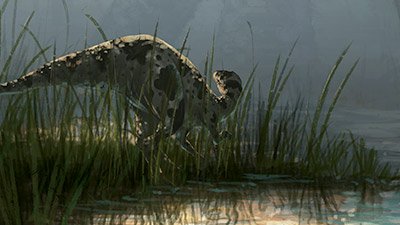T. Rex: Life in the Slow Lane
BBC NEWS: “T. rex was ‘slow-turning plodder’”
Fearsome, lethal Tyrannosaurus rex: a cunning, quick, dexterous dinosaur that ruled the ancient world, right? Not quite. Several of those attributes weren’t true of the famous T. rex, including—as is being reported this week—the idea that T. rex was a quick predator. On the contrary, a Stanford University team reports in the Journal of Theoretical Biology that T. rex “was unlikely to have topped 40km/h (25mph) and would [have taken] a couple of seconds to swivel 45 degrees[.]” The team came to this conclusion after detailed computer modeling of T. rex motion based on previous biomechanical work.
T. rex “was unlikely to have topped 40km/h (25mph) and would [have taken] a couple of seconds to swivel 45 degrees[.]”
One important principle that this research highlights is the substantial amount of guesswork that plays into our scientific understanding of the past. The science presented to the public—including to schoolchildren—is often caricatured and even distorted. This pseudoscientific environment, fueled by the rush of the media to repackage esoteric experiments into all-important, absolute facts, and general disinterest of the public to research things for themselves, is an obstacle to the constructive discussion of science. A prime example are the millions who blindly accept old-earth dating methods without even a modicum of understanding how the technique works. Many can claim dinosaurs died out long before man arrived on scene, but far fewer can explain how we “know” this.
Another interesting corollary of this new T. rex finding is that it minimizes one objection to the “cohabitation” of dinosaurs and humans (as is presented by the Bible and widely lampooned by anticreationists): that humans could not have survived amid carnivorous dinosaurs such as T. rex (which were not originally carnivorous, anyway, according to the book of Genesis). However, understanding that T. rex (and presumably other large, carnivorous dinosaurs) were not so swift on their feet helps us better conceptualize how our human ancestors would have dealt with wildlife threats—not unlike human populations who, even today, live near dangerous carnivores.
Remember, if you see a news story that might merit some attention, let us know about it! (Note: if the story originates from the Associated Press, Fox News, MSNBC, the New York Times, or another major national media outlet, we will most likely have already heard about it.) And thanks to all of our readers who have submitted great news tips to us.
(Please note that links will take you directly to the source. Answers in Genesis is not responsible for content on the websites to which we refer. For more information, please see our Privacy Policy.)

Answers in Genesis is an apologetics ministry, dedicated to helping Christians defend their faith and proclaim the good news of Jesus Christ.
- Customer Service 800.778.3390
- © 2024 Answers in Genesis




